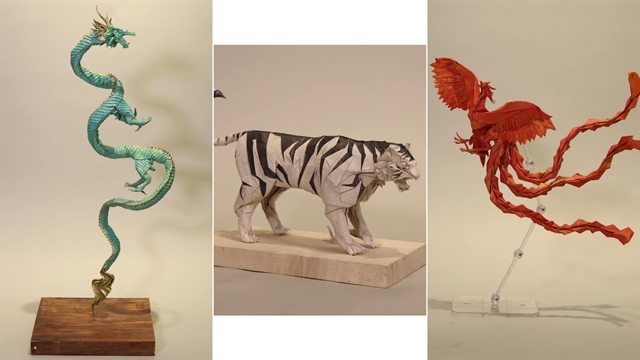 Sunday/Weekend
Sunday/Weekend

By Minh Phương
(Additional reporting by Hải Anh)
Origami is transforming into something uniquely Vietnamese through the hands of Nguyễn Nam Sơn, who uses traditional dó (poonah) paper to breathe new life into this centuries-old Japanese art.
 |
| Nguyễn Nam Sơn fell in love with origami in high school and then started using poonah paper in his art. Photo courtesy of Nguyễn Nam Sơn |
Like other people who have a passion for origami, which is the Japanese art of paper folding, Sơn fell in love with it in his final year of high school.
“I love reading manga,” Sơn said. “In grade 12, after reading Hiệp sĩ giấy (Origami Warrior), I started folding the characters from the manga. By searching online, I discovered that this technique was called origami.”
After years of practice, Sơn still finds the style fascinating.
“It’s truly magical,” he said. “With just a single square sheet, no cutting, no glueing, you can create any folded model, limited only by the artist’s imagination and skill.”
Sơn enjoys creating models of legendary creatures found in ancient myths, such as horses, dragons, phoenixes, unicorns, and deer.
The more complicated the models are, the more enthusiastic and eager he becomes.
 |
| Sophisticated origami models can take weeks to complete. Graphic by Minh Phương |
Folding a model goes through many stages, including designing a folding model, making a scratch on a designing application, folding it for testing, preparing poonah paper and then folding the final model.
Getting the right proportions on the paper is the most critical step to Sơn. If the proportions are even slightly off, the model might fail.
During the test-folding stage, Sơn checks the proportions again to make sure they are correct. If he finds any mistakes, he must start over from the beginning.
Secret behind the art
One thing that makes Sơn’s models stand out is the special paper he uses.
Born in Hoà Bình, where the famous poonah paper is made, Sơn grew up surrounded by this traditional craft. Poonah paper was once used for royal documents and for folk paintings such as those of Đông Hồ. Sơn saw its potential for something new.
Việt Nam’s poonah paper comes from the bark of the poonah tree. Its fibres naturally bond together, making the paper strong and flexible. However, poonah paper wasn’t originally made for origami, so it requires special preparation.
Sơn found ways to strengthen the paper by treating it with colours and glue, transforming it into a perfect material for folding while still preserving its natural beauty.
“Poonah paper usually comes in a light yellow colour and is very soft and thin,” Sơn said. “To make it strong enough for folding, I first add colour and glue. Then I dry it and reinforce it before using it for origami.”
He uses durable acrylic paints that won’t fade over time. After dyeing the paper, he adds glue, which soaks into the fibres and makes them stick together more tightly. This process makes the paper more flexible and strong, so his models can last for years.
Spreading the art
Origami is a bridge for Sơn to connect with friends around the world and share the unique qualities of Vietnamese materials with the public.
In 2016, Sơn submitted his piece God of the Forest to the Global Creative Jongie Jupgi Contest in South Korea, where it won second prize. The artwork is now on display at the Jong Ie Nara Museum in South Korea.
He also has two other works, Dragon and Kirin, on display at the Zaragoza Museum in Spain. The Dragon is his most complex design to date, crafted from a single sheet of paper. Creating this piece took him two months to design and another month to fold.
 |
| Two artworks, Dragon and Kirin, are on display at the Zaragoza Museum in Spain. Graphic by Minh Phương |
Beyond competitions, Sơn also runs weekend workshops to give young people a fresh way to connect with Vietnamese traditions.
“What we’re doing is great for cultural preservation, but we preserve culture so that the younger generation can connect with it more easily,” Sơn said.
“Now, when I host workshops and participants come, I tell them they’re holding a piece of Việt Nam’s cultural heritage in their hands, and they all go ‘wow’. They feel like they’re not just learning origami, but also carrying a piece of Vietnamese identity with them. That’s exactly what I hope to achieve, to ignite a passion for art and culture in young people.”
 |
| Sơn guides students at Đoàn Thị Điểm School how to make origami. Photo courtesy of Nguyễn Nam Sơn |
Lê Mạnh Khang, one of Sơn’s students, said learning origami had been a rewarding experience.
“In a life filled with endless worries, it helps me stay focused and feel at peace,” Khang said.
“After five lessons, I was able to fold figures like a horse, a fox and even some flowers. Looking at my finished pieces after each class brings me great joy and satisfaction.”
Sơn’s work today is more than just paper and folding. It’s a story of culture and creativity told through the delicate Japanese-based art. VNS

.jpg)







